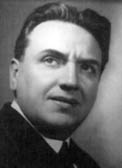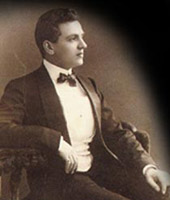Lightyears Collection
Ernest Beaux
(1881-1961)
|
Ernest Beaux was born on December 8, 1881, in the village of Suschevo "in Vedernikova's house" in Moscow, near the factory and offices of A. Rallet & Co. where his French father, Edouard Beaux, was employed as chief perfumer and member of Rallet's board of directors.
After finishing his secondary education in 1898, Ernest Beaux joined Rallet as a lab assistant in the soap works. Two years later he took a leave of absence for military service in France.
When Beaux returned to Moscow in 1902, he was assigned to Rallet's perfumery division, working under Rallet's technical director, A. Lemercier. Lemercier, a modern, original thinker, encouraged Beaux to explore new trends in perfumery and perfumery materials as well as new social and cultural trends.
In 1907 Beaux was elevated to the position of technical director and became a member of Rallet's board of directors.
Beaux's first perfume (name unknown) was released in 1907 but his first large success came in 1912 with his Bouquet de Napoleon, an eau de cologne that commemorated the centennial of the battle of Borodino, Napoleon's last but very bloody victory in Russia. The following year (1913) Beaux is said to have produced his Bouquet de Catherine, to celebrate the tercentennial of the Romanov dynasty. Some sources confuse this almost unknown fragrance with Brocard's The Empress's Favorite Bouquet which today is known as Red Moscow. Beaux speaks of the success of Bouquet de Napoleon in a 1946 lecture but makes no mention of the Bouquet de Catherine.
In 1914, with the outbreak of war, Beaux again found himself in the military. Beaux appears to have served in combat but after Russia left the War in 1917 and the fight with Germany ended in 1918, Lieutenant Beaux served as a counter intelligence officer in the multinational force that attempted to support the White Russian army in their effort to overthrow the Bolsheviks and thus restore the monarchy. Beaux, fluent in Russian, was to Arkhangel'sk and served at the prison on Mud'yug Island where Bolsheviks captured by the White Russian and Allied armies were held. While survivors of the camp were left with different impressions of Beaux, there was agreement that he was always elegant in his appearance. For his service between 1914 and 1919, he received medals from Britian, France and Imperial Russia.
In 1918 Beaux received word that he should not return to Moscow. In 1919, with his military service ended, Beaux was reunited with wife, son, friends, relatives and Rallet co-workers in France. Rallet, which had been purchased by Chiris in 1898, had set up operations at La Bocca, near Cannes. Again Beaux has his own perfume laboratory.
At La Bocca, Beaux was something of a celebrity to the younger French perfumers. These companions included Henri Robert, Henri Almeras, and Vincent Roubert. Henri Robert's father, Joseph Robert, was Chiris's technical director.
In his 1946 lecture, Beaux mentions his military service in lands above the arctic circle "where the rivers and lakes release a note of incredibly freshness". He committed this note to memory.
But even before 1914, Beaux had been experimenting with aldehydes, inspired in part by Houbigant's 1912 Quelques Fleurs, in which Houbigant perfumer, Robert Bienaimé, successfully made use of aldehyde C-12 MNA. It is believe that Beaux's Bouquet de Catherine was an effort to make use of these new materials. Although we do not know the exact year of its rebirth, Bouquet de Catherine evolved into Rallet Le No.1, first marketed by Rallet and later by Coty after Coty acquired Rallet in 1929.
During the years 1919 to 1920, — no doubt working from his Bouquet de Catherine experiments — Beaux developed a number of fragrances, including those that would become Chanel No.5 and Chanel No.22. In 1920, Beaux and Gabrielle "Coco" Chanel were introduced by Grand Duke Dimitri Pavlovitch. Dimitri had been exiled from Russia before the 1917 Bolshevik revolution for his role in the assassination of Rasputin and now, in France, had become Chanel's lover in an affair that lasted for about a year. Dimitri knew of Rallet and, quite likely, knew Beaux either personally or by reputation from their Moscow days.
In response to her request for a perfume, Beaux — according to his own words — presented her with two series of bottles, the first numbered 1 through 5, and the second, 20 through 24. According to Beaux' report of the meeting, she chose the bottle numbered "5" and, when asked what she would call it, told Beaux that she would call it "Number Five" — which she did.
 Ernest Beaux |
Between 1920 and 1922, Beaux produced a number of fragrances for Chanel, some no more than experiments. These deliveries were in small quantitites from his own lab at La Bocca. No.5 and No.22 and the ones that are remembered. Beaux lacked the capacity to manufacture these fragrances in larger quantities and Chanel lacked the ability to sell more than a handful of bottles.
In 1922, Beaux's laboratory at La Bocca became a favorite "tourist destination" for diplomats during the Conference of Cannes at which Germany reparations from the First World War were negotiated. Visitors to Beaux's laboratory included British Prime Minister, David Lloyd George, French Premier, Aristide Briand, and Louis Loucheur (who Time magazine later referred to as "the symbol of the reputable French profiteer.") In the same year Beaux agreed to represent his friend Eugene Charabot in Paris.
 Ernest Beaux |
In 1924, the year Ernest Wertheimer went into a perfume marketing partnership with Coco Chanel, Beaux was hired by Paul and Pierre Wertheimer to be the technical director of both Parfums Chanel and Bourjois, the Wertheimer's existing perfume and cosmetics business which already had achieved international distribution, including outlets in the United States.
During the 1930's, Chanel and Bourjois released a number of fragrances in which Ernest Beaux, no doubt, had a hand. But in a rare 1953 interview, Pierre Wertheimer explained to Time magazine that companies such as Chanel and Bourjois could each only afford to promote a single fragrance, and this fragrance would provide them with the bulk of their business. To promote more than a single fragrance was simply too expensive. For Chanel, No.5 was "the" fragrance; for Bourjois it was Soir de Paris.
Although New York based Henri Robert became Chanel's chief perfume in 1954, Beaux remained with the company until the year before his death when he was "let go." He died in his Paris apartment in 1961. His funeral was held in the south of France in the Parish of Notre Dame de Graz de Passy. It is said that the church was decorated with roses.
But did Beaux create his last classic in 1936? Beaux, by all accounts, worked every day and constantly experimented with ideas for perfume. During the 1940's, when Chanel had stopped offering new collections, a series of perfumes appeared under the name "Mademoiselle Chanel". While offering these fragrances violated her agreement with the Wertheimers, their existance — and Chanel's attempts to ship them to the United States — became a bit of a game she played with Pierre Wertheimer, who, she believed, was not giving her a large enough share of the profits on "her" fragrances.
A recent analysis of Chanel's Mademoiselle Chanel No. 1 (see "From Rallet No.1 to Chanel No.5 versus Mademoiselle Chanel No.1", Perfumer & Flavorist, October, 2007) has shown it's kinship to Chanel's No.5. Beaux is on record as having praised the fragrance and thus distanced himself from it, but this recent analysis has uncovered Beaux's "signature" in this fragrance making it unlikely that anyone but Beaux could have created it. A reconstitution of Mademoiselle Chanel No.1 — which exhibits a total lack of the aldehydes for which Beaux was famous but makes heavy use of another material that was new in the 1940s — has shown it to be an exquisite fragrance, on the level of Beaux's best work. Of course we may never know the truth about this fragance that quickly disappeared after Pierre Wertheimer negotiated a new agreement with Gabriel Chanel.
Perfumes Created By Ernest Beaux
| Fragrance | House | Year | Comments |
| Unknown | A. Rallet & Co. | 1907 | Beaux's first perfume |
| Bouquet de Napoleon | A. Rallet & Co. | 1912 | A large success |
| Bouquet de Catherine | A. Rallet & Co. | 1913 | No information available. |
| Le No.1 | Rallet | 1920 | |
| No.5 | Chanel | 1921 | Beaux's legendary creation |
| No.22 | Chanel | 1922 | |
| Cuir de Russie | Chanel | 1924 | |
| Gardénia | Chanel | 1925 | |
| Bois des îles | Chanel | 1926 | |
| Evening In Paris (Paris de Soir) | Bourjois | 1928 | |
| Kobako | Bourjois | 1936 | |
| Mademoiselle Chanel No.1 | Gabrielle Chanel | c.1942-1946 | Suspected to be an Ernest Beaux creation |
| Premier Muget | Bourjois | 1955 | Beaux's post war creation |
If you have any information on Ernest Beaux that you would like to share with us, please do so using the message sender below.
|


Philip Goutell
Lightyears, Inc.


